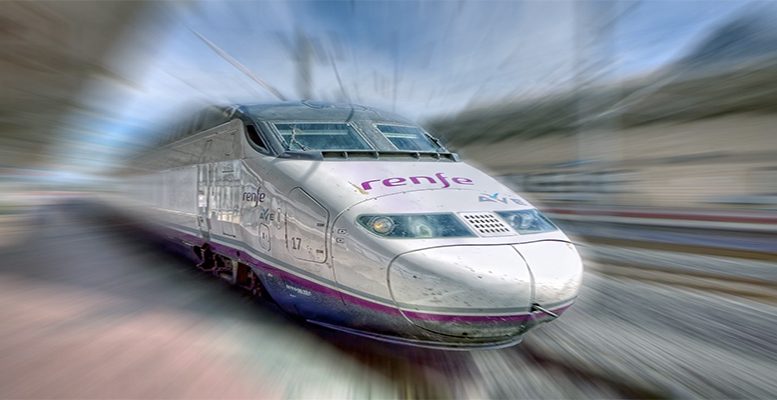The AVE high-speed train has undoubtedly been one of Spain’s big success stories and very positive for its international image. Spain is not just the European country with the most high speed tracks (2,900 km), in front of the pioneer (France), with 2,000, but it has also reached these levels in a little over 30 years. France took 30.
The problem is that the AVE, despite its popularity, is a very expensive infrastructure and very underused (yes!). It continues to require mega amounts of cash, accumulating debts and of course generating losses for ADIF Alta Velocidad, the track and stations operator, but also for Renfe.
Despite new lines coming into service, the actual high-speed train (not the AVE trains which go at a medium-speed) does not transport more than 20 million passengers per year. Except for Madrid-Barcelona and Madrid-Seville, there are in fact very few passengers who use the other lines and so the cost is not covered.
In fact, some lines have been closed to this service or are functioning below minimum. The situation will only get worse when new tracks are brought into operation, which are also not going to see much traffic and so will be loss-making.
That is the view of all the experts and professionals consulted and also of the international media who have looked at the matter of the high-speed train in Spain. Which is not surprising. In France, the SNCF does not hide the fact that the TGV is loss-making. So much so that they have begun to close tracks and stations. And if that happens with the TGV, with 122 million passengers, six times more than in Spain, then why not with the AVE. We need to remember that in France they transport 61,000 travellers per kilometre, in Italy 27,000 and Spain 11,000.
In one of the last few years, Renfe announced that its high-speed division had earned 95 million euros. This is of course its operating profit: once a whole series of expenses, depreciations, amortisations, taxes, transfers, financial costs and a long etc have been deducted, the result is negative.
Here it needs to be pointed out and acknowledged that as far as the AVE is concerned we don’t have enough information to make an analysis. Renfe is completely opaque about this issue. It does not provide figures on revenues, operating profit or net profit for the AVE. And even less information on results per track. Furthermore, it issues figures on revenues or operating profit which are erratic and confusing.
From its annual global results, we know it posted a net profit for the first time in 2015. This was 37 million euros, while total revenues from all its subsidiaries was over 3 billion. In 2016, all we know is that it posted an operating profit, based on a series of one-time revenues and one-off items, which will be reduced at the net level.
So whoever can’t make money with the AVE shouldn’t be suprised. It would certainly be in profits if it just did the Barcelona and Seville routes. But that is not the case. In any event, it’s a serious matter, because the AVE was designed to be profitable. The State has taken on huge investments in infrastructures (between 40 and 50 billion euros), 20 or 25% of which has been paid by European funds.
That said, apart from the obligation to operate non-profitable tracks, Renfe has invested more than 5.5 billion euros in rolling stock for the AVE (trains and engines). It would take over ten years of revenues just to pay for this equipment: and pay ADIF Alta Velocidad around 500 million euros every year, as a fee for using the tracks and stations.
These three circumstances, low traffic and non-profitable routes, the amortisation of the trains and the fee for using the infrastructure, certainly make it difficult – even imposible? – for Renfe to make money. Unless the traffic figures are multiplied four or five times.
Despite the fact the AVE has managed to win out against air travel in the routes to Seville – in part – and Barcelona, the virtuous circle has faded. The low cost airlines have reacted strongly and are blocking Renfe from boosting traffic. Another factor is the proliferation of offiers like BlablaCar and the price war started by the big bus companies. At the end of the day, let’s be honest. The AVE is very expensive – sometimes even more than the plane – and certaintly much dearer than the bus. It has become a product for the middle-class, which tax payers are paying for whatever their social class.
And here it’s worth noting that apart from the losses which the AVE produces for Renfe – and which eventually will end up as debt or be taken on by the State – there are also the losses generated by ADIF Alta Velocidad itself, almost 600 million euros between 2014 and 2015: 216 million in the first year and 362 million in the second. Plus debt of almost 14 billion euros.
Given all that, there are some who think it’s suicidal to continue to build new lines to Galicia, Extremadura etc. It’s well known they are not going be profitable and they will cost the government another 15-20 billion euros in the coming years. And will create further losses for Renfe.
Perhaps this explains why France, which began many years before Spain, only has 2,000 kms of high-speed track. But of course France doesn’t have autonomous regions, with permament grievances. The delays in the connections with Galicia and the Basque Country due to the crisis have fuelled an uproar in these regions, which feel undervalued compared with others. So it’s not likely there will be any halt. In Spain we will end up with an AVE which goes at 350 km per hour just under 50 kms from someone’s house. But can we afford it?





